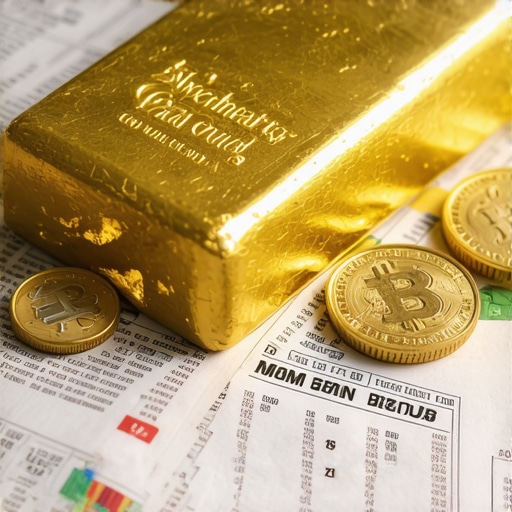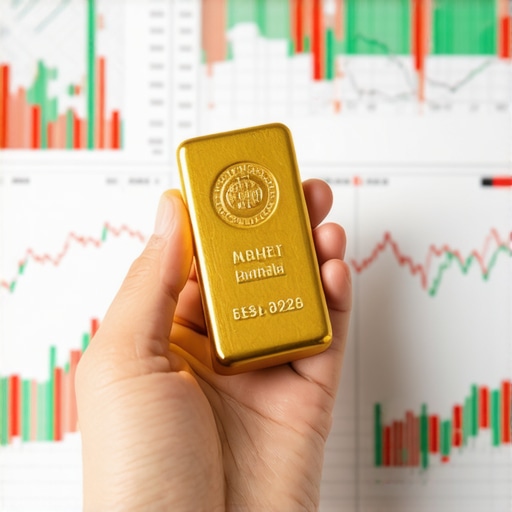Gold Fever: Why Beginners Keep Falling for the Gleam
Ah, gold — that timeless metal that has dazzled kings, queens, and investors alike for millennia. But for the newbie investor dipping toes into this glittering pool, the question isn’t just about the allure; it’s about managing the risks that come with the territory. After all, gold’s shine can sometimes blind you to the pitfalls lurking beneath.
Risk Management: The Unsung Hero of Gold Investing
Before you rush to buy that shiny bar or tempting coin, remember: investing in gold isn’t just a treasure hunt. It’s a strategic dance with volatility, market trends, and global economic twists. Seasoned investors know the importance of balancing the glitter with grounded risk management. As anyone who’s watched prices swing wildly can attest, gold’s value isn’t always the safe harbor it’s touted to be.
Is Gold Really the Safe Haven We Dream Of?
This question keeps popping up in conversations at coffee shops and online forums alike. Sure, gold has historically been a hedge against inflation and economic uncertainty, but does that mean you should bet the farm? Not quite. Diversification remains king. Holding gold alongside stocks and bonds can cushion your portfolio, but leaning too heavily on gold might leave you vulnerable to its own unique risks.
Practical Tips for Navigating the Golden Maze
For beginners, stepping carefully is the mantra. Start by understanding the types of gold investments available — from physical gold bars and coins to ETFs and mutual funds. If you’re curious about the safest ways to buy physical gold and avoid common pitfalls, resources like this beginner’s guide on buying gold coins safely can be a lifesaver.
Storage is another crucial aspect. Where and how you keep your gold can mean the difference between peace of mind and sleepless nights. Opt for trusted vaults or secure home safes with insurance. Remember, authenticity verification is non-negotiable; counterfeit gold is a real menace in the market.
What the Experts Say
According to the World Gold Council, gold remains a cornerstone for portfolio diversification, especially during turbulent times, but they stress the importance of understanding market cycles and geopolitical influences that can sway prices unpredictably (World Gold Council research).
So, how do you keep your golden ambitions grounded? By staying informed, cautious, and always ready to adapt your strategy as the market evolves. For a deeper dive into mastering gold market analysis, check out this insightful resource.
Join the Conversation
Have you dipped your toes into gold investing? What risk management hacks have worked for you? Share your sparkling stories or questions in the comments below — after all, every golden journey is better when traveled together!
Dynamic Risk Factors Shaping Gold’s Future
As we look ahead to 2025, gold’s role in portfolios is evolving amid shifting macroeconomic forces and geopolitical uncertainties. Factors such as rising inflation expectations, interest rate adjustments by central banks, and supply chain disruptions are influencing gold’s price volatility. Savvy investors must not only track these variables but also anticipate their interplay to position their gold holdings strategically.
For example, the increasing purchases of gold by central banks globally, as detailed in this analysis on central bank buying patterns, can signal shifts in market sentiment and price direction. Understanding these signals allows investors to act preemptively rather than reactively.
Integrating Gold ETFs: Flexibility Meets Tradition
While physical gold offers tangible security, many investors now complement their holdings with gold ETFs for liquidity and ease of trading. Gold ETFs can provide exposure to price movements without the challenges of storage and authentication. However, choosing the right ETF requires scrutiny of management fees, fund size, and underlying asset quality.
For beginners aiming to build a balanced portfolio that leverages both physical gold and ETFs, exploring best gold ETFs and mutual funds can provide actionable insights and help mitigate risks associated with market fluctuations.
How Can Investors Balance Physical Gold and Digital Gold Assets for Optimal Security?
This question strikes at the heart of modern gold investing. While physical gold boasts intrinsic, tangible value, digital gold assets like ETFs offer convenience and flexibility. The optimal balance depends upon individual risk tolerance, investment horizon, and market conditions. A hybrid approach often allows investors to enjoy the security of physical bullion while capitalizing on the agility of digital instruments.
Expert consensus suggests maintaining a core allocation to physical gold for long-term wealth preservation, supplemented with ETFs to seize short-term market opportunities and maintain liquidity. This strategy aligns with principles outlined by the Investopedia guide to gold investing, which emphasizes diversification within gold assets to optimize portfolio resilience.
Moreover, vigilant monitoring of market trends and periodic portfolio rebalancing are crucial to adapting to evolving economic landscapes. Engaging with resources such as best gold investment strategies can empower investors to refine their approach continually.
Community Insights: Share Your Gold Investment Experiences
What strategies have you found effective in managing the delicate balance between physical and digital gold investments? Are there particular ETFs or storage methods you’ve trusted? Your insights can illuminate paths for fellow investors navigating this complex terrain. Feel free to leave a comment below or share this article with your network to foster a richer dialogue on mastering gold investments in 2025 and beyond.
Refining Your Gold Portfolio: Beyond Basics to Strategic Asset Allocation
Once the foundational understanding of gold investments is established, the next frontier is mastering portfolio allocation that transcends simplistic splits. Investors are increasingly adopting nuanced models that integrate macroeconomic forecasts with behavioral finance insights to optimize gold’s role in their portfolios. This involves dynamically adjusting allocations in response to shifting interest rates, currency fluctuations, and geopolitical tensions — factors that can drastically alter gold’s risk-return profile.
For example, during periods of rising inflation expectations, an investor might increase physical gold holdings to hedge against currency debasement, while simultaneously paring back exposure to gold ETFs that might be more sensitive to short-term market sentiment. Conversely, when liquidity is paramount, reallocating toward ETFs can provide nimble entry and exit points.
What Are the Emerging Quantitative Models for Predicting Gold Price Movements?
Cutting-edge quantitative models leverage machine learning techniques and alternative data sources to forecast gold prices with increasing accuracy. Incorporating variables such as real-time social media sentiment, central bank transaction data, and geopolitical event indices, these models aim to capture the multifaceted drivers of gold’s price dynamics. For example, neural network models trained on decades of price data and macroeconomic indicators have demonstrated superior performance in anticipating volatility spikes compared to traditional econometric approaches.
However, the efficacy of these models depends heavily on data quality and interpretability. Investors utilizing these advanced tools must balance algorithmic insights with domain expertise to avoid overfitting or misinterpretation. The Journal of Finance provides a detailed analysis of these emerging quantitative strategies, emphasizing their potential and limitations.
Integrating ESG Considerations into Gold Investing: Ethical Dimensions and Market Impact
Environmental, Social, and Governance (ESG) criteria are reshaping investment paradigms across asset classes, and gold is no exception. Mining operations’ environmental footprints, labor practices, and governance transparency increasingly influence investor decisions. Sustainable gold sourcing, certified by initiatives like the Responsible Jewellery Council, can command premium valuations and reduce regulatory risks.
Investors incorporating ESG filters often seek gold producers with verifiable commitments to reducing carbon emissions, protecting biodiversity, and ensuring fair labor standards. Such diligence not only aligns portfolios with ethical standards but also anticipates regulatory trends that could affect supply chains and, ultimately, gold prices. Engaging with ESG ratings and third-party audits is critical for discerning genuine sustainability from “greenwashing.”
How Does ESG Integration Affect Gold’s Risk and Return Profile?
Integrating ESG factors into gold investment strategies may slightly limit the universe of available assets but can enhance long-term risk management by mitigating reputational and operational risks. Studies have shown that ESG-compliant gold mining companies tend to exhibit more stable cash flows and lower cost of capital. This translates into more resilient stock performance during market downturns, indirectly benefiting gold investors exposed through equities or ETFs.
For a comprehensive review of ESG impacts on gold investments, see the Sustainability Reports 2024 on Gold and ESG. This resource highlights empirical data supporting the financial materiality of ESG factors in precious metals markets.
Leveraging Technology in Gold Investment: Blockchain and Tokenization
Technology continues to disrupt traditional gold investing paradigms with innovations like blockchain-based gold tokens and smart contracts. Tokenization enables fractional ownership of physical gold stored in secure vaults, enhancing liquidity and accessibility for investors worldwide. This digital transformation also facilitates transparent provenance tracking, reducing counterfeiting risks and increasing trust.
However, the regulatory landscape surrounding tokenized gold remains fluid. Investors must navigate jurisdictional compliance and custody arrangements carefully. Partnering with reputable platforms that provide audited gold backing and robust security protocols is non-negotiable.
Exploring how these technological advancements complement traditional gold investing can provide a cutting-edge advantage. For those intrigued, this expert analysis on gold tokenization offers a deep dive into practical applications and risks.
Stay Ahead: Continuous Learning and Community Engagement
Gold investing in 2025 demands more than static knowledge; it requires an agile mindset and ongoing education. Engaging with expert analyses, quantitative forecasting tools, ESG developments, and technology trends will empower you to navigate complexities with confidence. Join professional forums, subscribe to authoritative newsletters, and participate in webinars to deepen your expertise.
Remember, the golden journey is as much about the process as the payoff. Share your experiences, ask probing questions, and learn from peers to refine your strategies continually.
Harnessing Advanced Analytics: The New Frontier in Gold Price Forecasting
For investors looking to outpace the volatility that gold markets notoriously exhibit, leveraging sophisticated analytical tools is no longer optional—it’s essential. Traditional forecasting methods, while foundational, often fall short in capturing the complex interplay of macroeconomic factors, geopolitical shocks, and emerging market sentiments that influence gold prices today. As we delve deeper into 2025, machine learning and artificial intelligence (AI) models are transforming how we anticipate gold’s price trajectories.
These cutting-edge models integrate vast datasets, including real-time social media sentiment, central bank gold transactions, global inflation metrics, and geopolitical risk indices. Such multidimensional analysis enables the detection of subtle market signals that might be overlooked by human analysts. However, the challenge remains balancing algorithmic output with seasoned market wisdom to avoid pitfalls like overfitting or misreading transient market noise.
How Are Neural Networks and Alternative Data Revolutionizing Gold Market Predictions?
Neural networks, a subset of AI, mimic human brain functions to identify nonlinear patterns and correlations within complex datasets. When applied to gold price forecasting, these networks ingest decades of historical price data alongside macroeconomic indicators, geopolitical event markers, and even crowd-sourced sentiment metrics. This fusion allows for more adaptive and nuanced models that can anticipate volatility spikes or sustained trends with improved accuracy.
For instance, a recent study published in the Journal of Finance highlights how integrating alternative data—such as social media analytics—into neural network models substantially enhances predictive performance compared to classical econometric approaches. Nonetheless, experts caution that these models require continuous refinement and expert oversight to ensure reliability.
Investors eager to harness these advanced forecasting techniques can explore expert insights on mastering gold market analysis to deepen their understanding of how technology and market fundamentals converge.
Strategic Portfolio Adjustments: Aligning Quantitative Insights with Tactical Gold Investment
Integrating machine learning-derived forecasts into portfolio strategy demands agility and strategic foresight. Investors should consider dynamic allocation models that adapt gold holdings based on predictive signals of inflationary pressures, central bank buying trends, and geopolitical tensions. This approach contrasts with static allocation, offering a refined balance between physical bullion, ETFs, and mining equities tailored to anticipated market phases.
For example, when models signal an impending uptick in geopolitical risk, increasing physical gold exposure might safeguard wealth, whereas signals favoring liquidity could justify shifting towards gold ETFs or mutual funds with lower transaction costs and higher market responsiveness. Resources like best gold investment strategies to maximize long-term gains provide actionable frameworks for implementing these nuanced tactics.
Emerging Challenges and Opportunities: Navigating Volatility in a Digitally Enhanced Market
While technological advancements offer unprecedented predictive capabilities, they simultaneously introduce new layers of complexity and systemic risk. Market participants must remain vigilant against algorithmic herd behaviors that could amplify volatility or precipitate flash crashes. Moreover, regulatory frameworks governing data usage and AI transparency are evolving, influencing model deployment and investor confidence.
Staying informed about these developments is crucial. Engaging with community discussions and expert forums can provide early warnings and collaborative strategies to mitigate associated risks. Readers interested in proactive risk navigation can benefit from guidance on handling gold market volatility with confidence.
Join the Expert Dialogue: Share Your Experience with Quantitative Gold Investing
Have you integrated machine learning or alternative data insights into your gold investment approach? What successes or challenges have you encountered? Your firsthand perspectives can enrich this evolving discourse and assist fellow investors in refining their strategies.
Drop a comment below to join the conversation or share this article with your network to spark broader engagement on mastering gold price forecasting and strategic portfolio management in 2025.
Expert Insights & Advanced Considerations
1. Dynamic Allocation Enhances Portfolio Resilience
Seasoned investors recognize that gold’s role is not static; adjusting allocations between physical gold, ETFs, and mining equities in response to macroeconomic signals—such as inflation trends or central bank activity—can optimize risk management and return potential. This dynamic approach contrasts with fixed-percentage holdings and allows for tactical positioning aligned with market forecasts.
2. ESG Integration is Becoming Non-Negotiable
Incorporating Environmental, Social, and Governance criteria into gold investments is increasingly vital. Not only does this mitigate operational and reputational risks associated with mining practices, but ESG-compliant gold assets often demonstrate more stable cash flows and resilience in downturns. Investors should prioritize mining companies and funds with transparent sustainability commitments.
3. Machine Learning Models Are Revolutionizing Price Forecasts
Advanced forecasting now harnesses neural networks and alternative data—like social sentiment and geopolitical indicators—to anticipate gold price movements with greater nuance. While these tools enhance predictive accuracy, blending algorithmic insights with human expertise is essential to navigate model limitations and avoid overreliance on black-box outputs.
4. Tokenization Offers Accessibility but Demands Vigilance
Blockchain-based gold tokens democratize access to gold investing by enabling fractional ownership and improving liquidity. However, investors must carefully assess platform credibility, regulatory compliance, and custody arrangements to mitigate risks unique to digital assets.
5. Community Engagement and Continuous Learning Are Key
Gold investing in 2025 is a dynamic discipline requiring ongoing education and peer interaction. Engaging with expert forums, webinars, and professional analyses ensures investors stay ahead of evolving market conditions and technological innovations.
Curated Expert Resources
- World Gold Council Research: A premier source offering comprehensive data and insights on gold investment strategies and market dynamics (gold.org).
- BuyingGoldNow’s Mastering Gold Market Analysis: An in-depth guide to leveraging both traditional and modern analytical tools for savvy investment decisions (buyingoldnow.com).
- Journal of Finance – Quantitative Forecasting Gold Prices: Scholarly articles detailing cutting-edge machine learning applications and alternative data integration in gold price prediction (journaloffinance.org).
- Responsible Jewellery Council: A key certification body promoting sustainable gold sourcing and ethical mining practices (responsiblejewellery.com).
- BuyingGoldNow’s Best Gold Investment Strategies to Maximize Long-Term Gains: Practical frameworks for portfolio optimization and tactical gold allocation (buyingoldnow.com).
Final Expert Perspective
Gold investing is no longer just about securing a glittering asset; it demands a multifaceted, strategic approach that blends traditional wisdom with technological innovation and ethical considerations. Understanding how to balance physical gold with ETFs and digital tokens, while dynamically adjusting exposure based on advanced market analytics, is essential for portfolio resilience in 2025. Embracing ESG factors further fortifies investment quality and aligns with evolving market expectations.
As you refine your gold investment strategy, consider integrating insights from expert analyses and engaging with communities that challenge and expand your perspectives. For a comprehensive understanding of various gold investment vehicles, explore top types of gold investments from bars to ETFs explained and deepen your practical knowledge with quick tips for new investors buying physical gold safely. Your journey toward mastering gold investing is ongoing—stay curious, stay informed, and contribute your expertise to the vibrant conversation shaping this timeless yet ever-evolving market.










